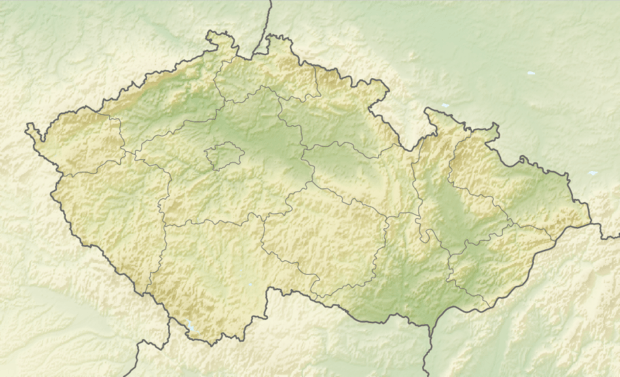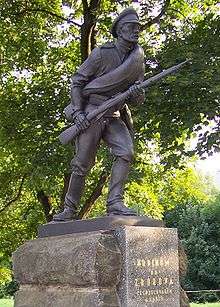Blansko
| Blansko | |||
| Town | |||
.jpg) View on the town | |||
|
|||
| Country | Czech Republic | ||
|---|---|---|---|
| Region | South Moravian | ||
| District | Blansko | ||
| River | Svitava | ||
| Elevation | 276 m (906 ft) | ||
| Coordinates | 49°22′N 16°39′E / 49.367°N 16.650°ECoordinates: 49°22′N 16°39′E / 49.367°N 16.650°E | ||
| Area | 50.56 km2 (20 sq mi) | ||
| Population | 20,800 (2015) | ||
| Density | 411/km2 (1,064/sq mi) | ||
| First mentioned | 1136 | ||
| Mayor | Ivo Polák | ||
| Timezone | CET (UTC+1) | ||
| - summer (DST) | CEST (UTC+2) | ||
| Postal code | 678 01 | ||
 Location in the Czech Republic | |||
| Wikimedia Commons: Blansko | |||
| Website: www.blansko.cz | |||
Blansko (Czech pronunciation: [ˈblansko]; German: Blanz) is a town in Blansko District in the South Moravian Region of the Czech Republic. Blansko is the biggest town in Blansko District to which it lends its name. Blansko is situated in the valley of the river Svitava. The centre of Blansko is 276 metres above sea level, with the majority of the city situated on a slope above the left bank of the Svitava. Blansko currently occupies an area of 18.29 km2 (7.06 sq mi) and has approximately 20,800 inhabitants as of 2015. The town is notable for the proximity of the Moravian Karst.
History
Blansko was mentioned for the first time as the site of dispute between Jindřich Zdík, the bishop of Olomouc and Prince Vratislav of Brno regarding the rights to construct a church in the village on the right bank of the Svitava river in 1136. In 1277 Bruno von Schauenburg then Bishop of Olomouc and landlord founded a village on the left bank of the Svitava. Originally known as 'New Blansko' it became the core of the modern city. After the founding of New Blansko, the villages went through possession of various landowners. The two villages finally merged to a single one in 1526.
From 1698 the Gellhorn family founded the first foundry and ironworks in Blansko. After 1766 the town belonged to the Salm family, who patronized many artisans and scientists, including Josef Dobrovský. Blansko also underwent vast expansion connected to the growth of ironworks under the guidance of Hugo František Salm. In January 1849 the first train arrived to Blansko on newly constructed Brno-Česka Trebova railway line. In 1905, Franz Joseph I of Austria granted Blansko the status of City and produced a commemorative certificate which contains the situation in Blansko at that time as relating to industry, education, associations etc. In 1949 Blansko became the capital of Blansko District instead of Boskovice.
Blansko still has many factories today though the significance of the town as industry hub has dropped. Many manufacturers are still operational in Blansko including: mechanical engineering hydroelectric water turbines and steam turbines concern following traditions of ČKD Blansko (in joint activities with Syzran industry Tyazhmash plant) , measuring instrument manufacturer Metra Blansko and a Českomoravsky Beton cement factory.
Parts of town
- Zborovce
- Sever
- Blansko-město ((Blansko Town))
- Staré blansko (Old Blansko))
- Staré bytovky (9. května)
- Písečná
Sights
Interesting places

- Klamova huť. A well preserved foundry and ironworks from 1850s. Former museum of cast iron artworks currently turned to production facility again.
- Château Blansko. Built likely in 1431 but first mention is in a reliable source dated to 1532. Currently the Castle serves as the seat of Blansko Museum.
- Blansko Museum. The museum presents permanent exhibitions of Moravian Karst and its exploration, the Oldest Ironworks, Iron Industry and Cast Iron in the 19th and 20th century, the history of measuring devices produced in Blansko and the history of the chateau and Blansko region. Many other temporary exhibitions, cultural events and music concerts are held there on a regular basis.
- Baroque Church of St. Martin. Built between 1672-1691. Originally a Romanesque church built in the 12th century by bishop Jindřich Zdík. The church has one of the oldest bell still extant in Moravia and is an important stop on the pilgrimage route 'Via Sancti Martini' for Martin of Tours.
- A wooden church of Saint Paraskieva built in the 17th century at Transcarpathian Ruthenia (present day Ukraine) and transported to Blansko in 1936.
- The memorial to the Czech Legionaries who were present at the Battle of Zborov.
- Municipal Library Blansko - District Library
- City Gallery Blansko - exhibitions of fine arts
- City Club Blansko - club facilities with a large hall and stage, small halls and clubrooms; part of the club's restaurant with summer garden
- Cinema Blansko - built in early 1920s
Notable Persons
- Karel Jezek (1851–1919), founder of the thriving industrial company in Blansko, longtime mayor Blanska, contributed to his promotion of the city in the year. 1905
- Karel Jaroslav Masek (1851–1916), archaeologist, explorer world-famous archaeological sites Předmostí by Přerova and cave arrow near Štramberk
- Vaclav Hugo Sáňka (1859–1929), speleologist, archaeologist, chronicler of Blansko
- Jaroslav Bakeš (1871–1930), a physician, a prominent surgeon, founder of the Institute for cancer patients in Brno
- Josef Pilnáček (1883–1952), an important Moravian historian and genealogist
- Rudolf Barak (1915–1995), government official, Interior Minister 1953-1961
- Ludvik Danek (1937–1998), Olympic champion in discus throw
- Roman Meluzín (born 1972), hockey player
In addition to the natives of the city there are also other personalities who stayed there for some time and have some link to the city:
- Carl Reichenbach (1788–1869), chemist, metallurgist and industrialist who in 1833 invented the paraffin in Blansko
- Ludwig Georg Treviranus (1790–1869), engineer, designer of the first industrially usable steam engines manufactured in the Czech Republic and in Central Europe
- Jindrich Wankel (1821–1897), doctor, Moravian archaeologist and speleologist
- Karel Absolon (1877–1960), a leading researcher in the Moravian Karst
- Erich Roučka (1888–1986), inventor and founder of a factory for the production of electrical measuring instruments (later Metra Blansko)
- Miloslav Kala (born 1963), economist and politician
- Jaromir Blazek (born 1972), soccer goalkeeper and former representative of the Czech Republic
- Yvetta Hlaváčová (born 1975), Czech Republic national team in the long-distance swimming and occasional model
At the church of St Martin there is a memorial plaque for Caroline Meineke, who was supposed to be the first wife of William IV of the United Kingdom. She spent the last years of her life at the Château in Blansko, where she died in 1815.
Twin Sister Cities
References
External links
| Wikimedia Commons has media related to Blansko. |

